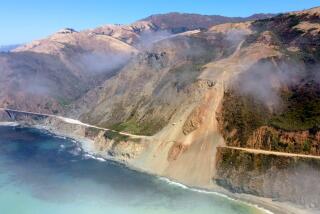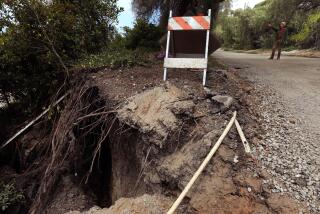Tollways Seek Ways to Win Battle of Bulge
Unstable bedrock beneath parts of Orange County’s toll road system has buckled pavement and damaged storm drains, problems that might worsen and require the costly replacement of the earth beneath sections of the asphalt.
One of the most glaring examples is a massive bump that’s grown in the middle of the San Joaquin Hills toll road in Laguna Canyon, according to a new Caltrans study that examined nearly 30 trouble spots on the 51-mile network of turnpikes.
The agency’s three-volume report blames the flaws on sandy silt stone and claystone bedrock beneath sections of the Eastern, Foothill and San Joaquin Hills toll roads, which are operated by the Irvine-based Transportation Corridor Agencies.
Tollway officials described the damage as a minor problem that is not uncommon after a massive amount of soil is shifted in extreme terrain. To cut a path for the Eastern tollway, for instance, 67 million cubic yards of soil -- equal to a quarter of that excavated for the Panama Canal -- had to be moved.
However, Caltrans officials are trying to determine whether adequate geological studies were conducted by TCA’s private contractors before the highways were built. No conclusions have been reached.
The Caltrans study concludes that bedrock beneath parts of the toll roads can swell when water migrates under the pavement, especially after rains.
Silt and claystone, the report says, are common in the excavated areas of the tollway system and could cause further damage. If so, earth beneath the trouble spots might have to be removed and replaced to a depth of more than 10 feet below the pavement.
“The potential is there for more bumps. How much we do not know,” said Sharid Amiri, who heads Caltrans’ geotechnical division in Orange County. “It depends on a lot of factors, including rain and soil conditions.
The study is part of an effort by Caltrans and the corridor agencies to cope with bumps that appeared in 1999 on the Eastern toll road between the Laguna and Riverside freeways.
Since then, officials have found 25 bumps in eight clusters along the toll roads and storm drain damage at four spots on the Foothill and Eastern toll roads. The width of the bumps ranges from 2.2 yards to 9.1 yards. Their height is no more than 2 inches.
The storm drain damage includes bent culverts and broken walls in the Windy Ridge and Loma Ridge areas, two of the bumpiest sections of the Eastern toll road.
On the San Joaquin Hills tollway, a 51.4-square-yard bump has developed on the southbound side between Laguna Canyon Road and the El Toro Road exit. The pavement has been lifted 1 1/4 to 1 1/2inches.
To remove any safety threat, Caltrans, the TCA and the road’s builder have spent almost $440,000 on studies, surveys and temporary repairs, such as grinding down the bumps and repaving them.
TCA officials plan to set aside an additional $300,000 for similar repairs in the Windy Ridge, Loma Ridge and Handy Creek Road areas. The proposal is scheduled to go before the Foothill-Eastern board in October.
Corridor officials said there have been no reports of traffic accidents or vehicle damage from the bumps.
There is some concern that the expansive bedrock could become a chronic maintenance and safety problem for the TCA and Caltrans, which maintains the tollway system. Whether the bumps will continue to grow or spread remains unclear.
Caltrans’ report recommends several repair options, ranging from inexpensive patches to more costly work such as excavating and refilling the sites with new material, adding drainage systems and repaving the roads.
Another Caltrans study is underway to determine the cost of the options and which solutions might be the most effective for each section where the bumps have appeared.
For the San Joaquin Hills tollway, Caltrans recommended the more extensive repairs that call for full or partial excavations, new pavement, and drainage systems between the paved shoulder and unprotected slopes next to the road.
But James Brown, the TCA’s chief engineer, opposes the most expensive option, saying the problem will diminish over time, allowing the highways to be repaired with less costly patches.
More to Read
Sign up for Essential California
The most important California stories and recommendations in your inbox every morning.
You may occasionally receive promotional content from the Los Angeles Times.











